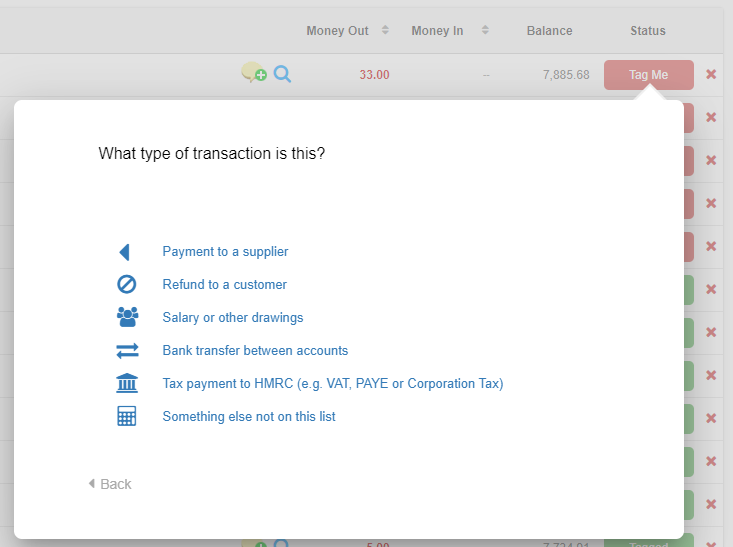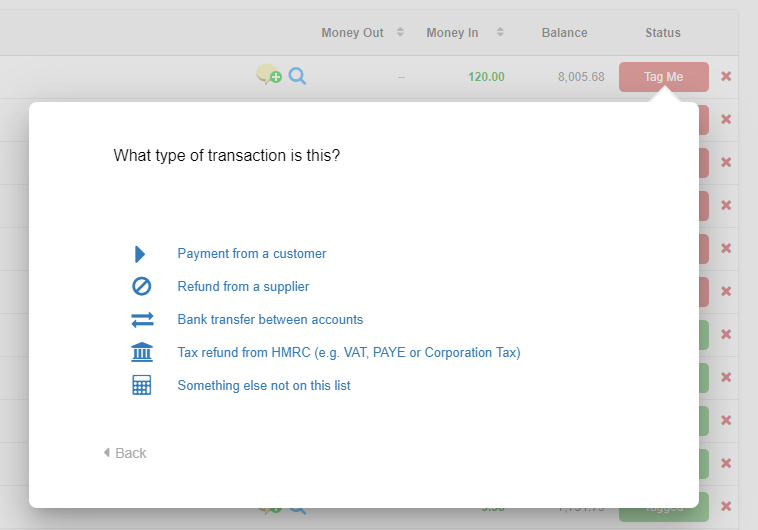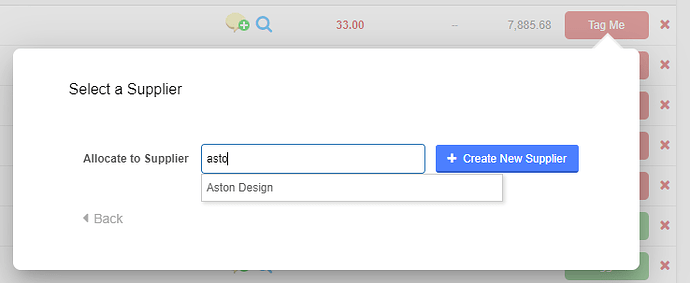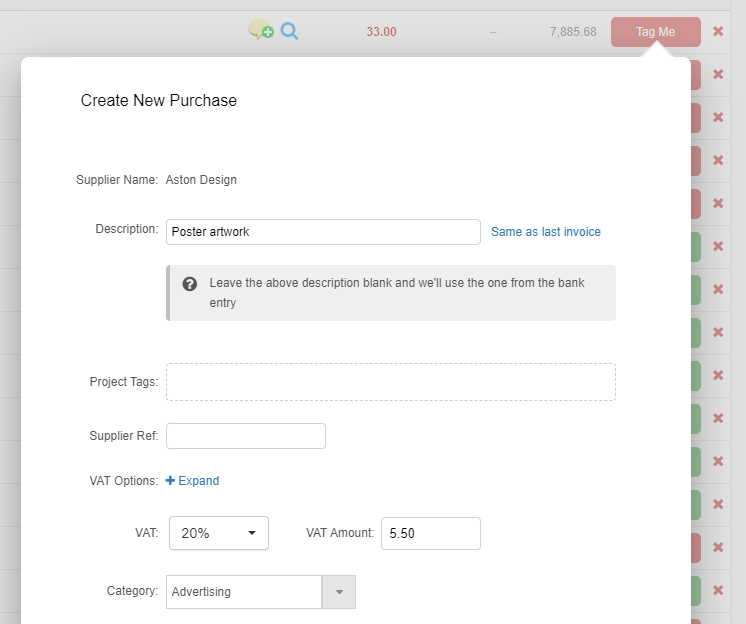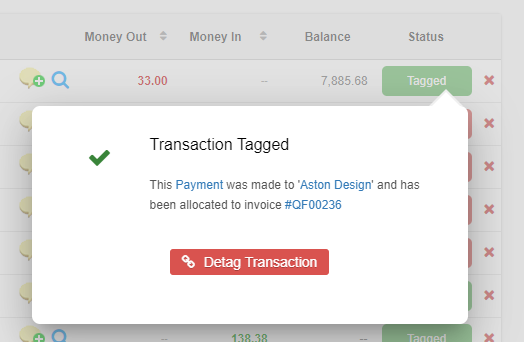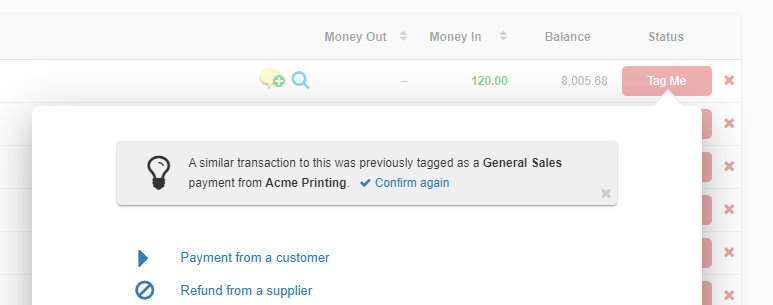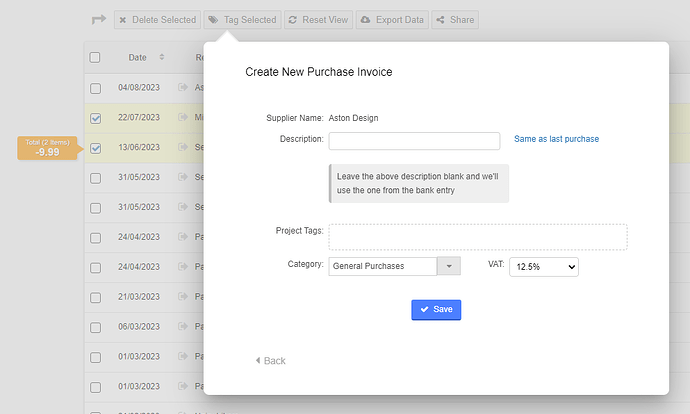Tagging your bank transactions
What is bank tagging?
When you connect a bank feed or upload your bank statement to QuickFile, you will notice that the individual transactions are highlighted in red as “Tag Me”. The tagging process allows you to work through the bank statement and provide an explanation as to the nature of each transaction, this is typically one of several things:
- Client payments (usually allocated to a sales invoice).
- Supplier payments (usually allocated to a purchase invoice).
- Salary payments or drawings
- Tax payments, e.g. Corporation Tax, PAYE or VAT.
- Bank transfers
If none of the preset options are a perfect fit you can also post directly to a nominal ledger of your choice. You can tag items individually or in batches of up to 50. QuickFile will take you through a simple wizard and automatically create the backing invoices, client/supplier records and bank movements.
In a nutshell, Bank Tagging allows you to work through large periods of bookkeeping in no time at all!
How to tag a bank transaction
Once you have uploaded your bank statement click on the Tag Me button for one of the new entries. A small window will pop up with numerous options. The precise options will depend on whether the transaction is a debit (money out) or a credit (money in).
Options for “money out” transactions:
Options for “money in” transactions:
In our example lets assume we have selected a payment that was made to a supplier for goods/services. So in this case we need to choose the option “Payment to a supplier”.
You can now select an existing supplier to tag this transaction to, or you can create a new one by just typing in the name.
Now simply enter a description for this item, define a category, enter any project tags (if applicable), and enter any VAT that should be applied (if applicable):
You have now successfully tagged a transaction, it should now be green and marked as Tagged.
If you click the green Tagged button you’ll see a brief summary of where the funds were allocated. You can even drill down on the invoice or supplier record and add additional information should you wish.
Bank Tagging Insights
Bank Tagging Insights uses machine learning to generate recommendations based on similar transactions you’ve recorded in the past. You can then choose to confirm or ignore the recommendation.
If an insight is confirmed the backing invoice will be created and you will be given an option to create a bank tagging rule to automatically tag in the same way in future.
We’ll also scan for any open (unapid) invoices so you can conveniently link the payment to the invoice.
Please note: Bank Tagging Insights is available for accounts with a Power User Subscription.
Bulk tagging transactions
Bulk tagging works in much the same way as single tagging, but allows you to select up to 50 items at a time on your bank and apply the same explanation.
Here’s how it works…
First, you need to find a set of transactions that relate to the same client, supplier or transfer. Within the QuickFile bank statement screen, you will see a magnifying glass for each bank statement entry. This will allow you to search for similar transactions and to then drill down into those matching entries. You can also perform an advanced search by clicking the Search button above the statement preview.
You can now select all the items using the corresponding checkboxes and then click the ‘Tag Selected’ button. You will see a series of options similar to those available on the individual tagging pop-up.
With the items selected all you need to do now is follow the options on the wizard, as you would on the single tagging process. Once confirmed all your backing records (e.g. sales or purchase invoices, transfers etc) are automatically created.
Don’t forget to keep an eye on the tagged transaction count in the top right-hand corner of your QuickFile statement. This will allow you to visually see how many of your transactions still need to be tagged. You can even click on the tick boxes next to the count to hide or show tagged or untagged transactions.

Auto tagging rules
Do you have many repeat payments to suppliers, bank transfers or client receipts? If so you may want to set up some auto-tagging rules on your account to fully automate the bank tagging process.
Auto-tagging works by allowing you to match transactions that either start with, contain or end with a particular name/reference. You can then tell QuickFile how such matching items should be tagged.
You can find out more about automatic bank tagging here.
How often should I tag my bank transactions?
Ideally, we recommend you set up a bank feed to ensure that your bank transactions are synchronised every 24 hours. As you tag these entries you will be prompted to create a bank tagging rule, so that next time any similar such transactions will be either auto-tagged or presented for you to confirm.
If you aren’t able to setup a bank feed we’d recommend that you import your most recent bank statement information every month at the most and to bulk tag those transactions. If you only have a handful of transactions to process in one month you may want to complete this process on a quarterly basis.
Whatever you decide please bear in mind two things:
-
You will only be able to obtain useful reporting information when the corresponding period is brought up to date.
-
You must ensure that all transactions have been tagged within three months following your year-end date (for Limited Companies). This will give our accountants ample time to prepare your annual accounts.
Conclusion
Bank tagging is a really fast way to complete your bookkeeping. It will allow you to quickly tell us about your transactions and what they relate to. As you tag your transactions, watch your reports come alive with useful insights!

